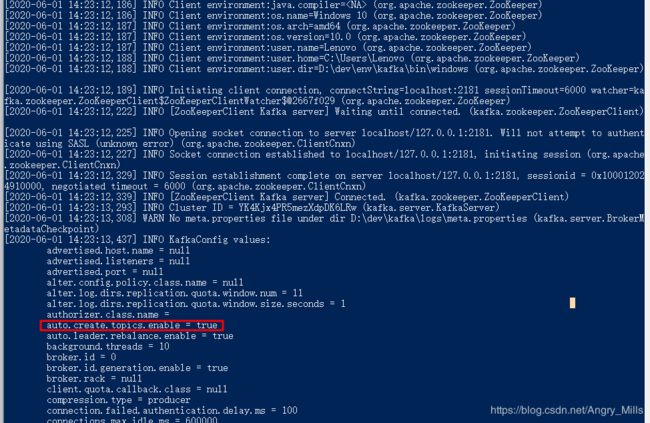springboot 整合 kafka demo 顺便看一下源码
大家好,我是烤鸭:
今天分享下 springboot 整合 kafka。
1. 环境参数:
windows + kafka_2.11-2.3.0 + zookeeper-3.5.6 + springboot 2.3.0
2. 下载安装zookeeper + kafka
zookeeper:
https://mirror.bit.edu.cn/apache/zookeeper/zookeeper-3.5.8/apache-zookeeper-3.5.8-bin.tar.gz
复制 zoo_sample.cfg ,改名为 zoo.cfg,增加日志路径:
dataDir=D:\xxx\env\apache-zookeeper-3.5.6-bin\data
dataLogDir=D:\xxx\env\apache-zookeeper-3.5.6-bin\log启动zk,zkServer.cmd
kafka:
https://kafka.apache.org/downloads
找 Binary downloads 下载
https://archive.apache.org/dist/kafka/2.3.0/kafka_2.12-2.3.0.tgz
修改 config/server.properties,由于zk用的默认端口 2181,所以不需要改
log.dirs=D:\\xxx\\env\\kafka\\logs
启动kafka
D:\xxx\env\kafka\bin\windows\kafka-server-start.bat D:\xxx\env\kafka\config\server.properties3. springboot 接入
pom.xml
org.springframework.boot
spring-boot-starter
org.springframework.kafka
spring-kafka
org.projectlombok
lombok
true
org.springframework.boot
spring-boot-starter-test
test
org.junit.vintage
junit-vintage-engine
org.springframework
spring-web
org.springframework.boot
spring-boot-starter-web
2.3.0.RELEASE
compile
application.yml
spring:
kafka:
# 指定kafka server的地址,集群配多个,中间,逗号隔开
bootstrap-servers: 127.0.0.1:9092
# 生产者
producer:
# 写入失败时,重试次数。当leader节点失效,一个repli节点会替代成为leader节点,此时可能出现写入失败,
# 当retris为0时,produce不会重复。retirs重发,此时repli节点完全成为leader节点,不会产生消息丢失。
retries: 0
# 每次批量发送消息的数量,produce积累到一定数据,一次发送
batch-size: 16384
# produce积累数据一次发送,缓存大小达到buffer.memory就发送数据
buffer-memory: 33554432
# 指定消息key和消息体的编解码方式
key-serializer: org.apache.kafka.common.serialization.StringSerializer
value-serializer: org.apache.kafka.common.serialization.StringSerializer
properties:
linger.ms: 1
# 消费者
consumer:
enable-auto-commit: false
auto-commit-interval: 100ms
key-deserializer: org.apache.kafka.common.serialization.StringDeserializer
value-deserializer: org.apache.kafka.common.serialization.StringDeserializer
properties:
session.timeout.ms: 15000
group-id: group
server:
port: 8081KafkaDemoController.java
package com.mys.mys.demo.kafka.web;
import com.mys.mys.demo.kafka.service.KafkaSendService;
import org.apache.kafka.clients.admin.AdminClient;
import org.apache.kafka.clients.admin.AdminClientConfig;
import org.apache.kafka.clients.admin.NewTopic;
import org.springframework.beans.factory.annotation.Autowired;
import org.springframework.kafka.core.KafkaAdmin;
import org.springframework.kafka.core.KafkaTemplate;
import org.springframework.web.bind.annotation.GetMapping;
import org.springframework.web.bind.annotation.RequestParam;
import org.springframework.web.bind.annotation.RestController;
import java.util.Arrays;
import java.util.HashMap;
import java.util.Map;
@RestController
public class KafkaDemoController {
@Autowired
private KafkaTemplate kafkaTemplate;
@Autowired
KafkaSendService kafkaSendService;
@GetMapping("/message/send")
public boolean send(@RequestParam String message) {
//默认自动创建,消费者端 allow.auto.create.topics = true
//createTopic();
kafkaTemplate.send("testTopic-xxx15", message);
return true;
}
//同步
@GetMapping("/message/sendSync")
public boolean sendSync(@RequestParam String message){
kafkaSendService.sendSync("synctopic",message);
return true;
}
//异步示例
@GetMapping("/message/sendAnsyc")
public boolean sendAnsys(@RequestParam String message){
kafkaSendService.sendAnsyc("ansyctopic",message);
return true;
}
/**
* @Author
* @Description 创建主题
* @Date 2020/5/23 19:03
* @Param []
* @return void
**/
private void createTopic() {
Map configs = new HashMap<>();
configs.put(AdminClientConfig.BOOTSTRAP_SERVERS_CONFIG,
"127.0.0.1:9092");
KafkaAdmin admin = new KafkaAdmin(configs);
NewTopic newTopic = new NewTopic("testTopic-xxx15",1,(short)1);
AdminClient adminClient = AdminClient.create(admin.getConfigurationProperties());
adminClient.createTopics(Arrays.asList(newTopic));
}
} KafkaSendService.java
package com.mys.mys.demo.kafka.service;
import com.mys.mys.demo.kafka.handler.KafkaSendResultHandler;
import org.apache.kafka.clients.producer.ProducerRecord;
import org.springframework.beans.factory.annotation.Autowired;
import org.springframework.kafka.core.KafkaTemplate;
import org.springframework.kafka.support.SendResult;
import org.springframework.stereotype.Service;
import org.springframework.util.concurrent.ListenableFuture;
import org.springframework.util.concurrent.ListenableFutureCallback;
import java.util.concurrent.ExecutionException;
import java.util.concurrent.TimeUnit;
import java.util.concurrent.TimeoutException;
@Service
public class KafkaSendService {
@Autowired
private KafkaTemplate kafkaTemplate;
@Autowired
private KafkaSendResultHandler producerListener;
/**
* 异步示例
* */
public void sendAnsyc(final String topic,final String message){
//统一监听处理
kafkaTemplate.setProducerListener(producerListener);
ListenableFuture> future = kafkaTemplate.send(topic,message);
//具体业务的写自己的监听逻辑
future.addCallback(new ListenableFutureCallback>() {
@Override
public void onSuccess(SendResult result) {
System.out.println("发送消息成功:" + result);
}
@Override
public void onFailure(Throwable ex) {
System.out.println("发送消息失败:"+ ex.getMessage());
}
});
}
/**
* 同步示例
* */
public void sendSync(final String topic,final String message){
ProducerRecord producerRecord = new ProducerRecord<>(topic, message);
try {
kafkaTemplate.send(producerRecord).get(10, TimeUnit.SECONDS);
System.out.println("发送成功");
}
catch (ExecutionException e) {
System.out.println("发送消息失败:"+ e.getMessage());
}
catch (TimeoutException | InterruptedException e) {
System.out.println("发送消息失败:"+ e.getMessage());
}
}
} CustomerListener.java
package com.mys.mys.demo.kafka.consumer;
import org.springframework.kafka.annotation.KafkaListener;
import org.springframework.stereotype.Component;
@Component
public class CustomerListener {
@KafkaListener(topics="testTopic")
public void onMessage(String message){
System.out.println("消费="+message);
}
@KafkaListener(topics="testTopic-xxx14")
public void onMessage1(String message){
System.out.println("消费="+message);
}
@KafkaListener(topics="testTopic-xxx15")
public void onMessage15(String message){
System.out.println("消费="+message);
}
}KafkaSendResultHandler.java(用于接收异步的返回值)
package com.mys.mys.demo.kafka.handler;
import org.apache.kafka.clients.producer.ProducerRecord;
import org.apache.kafka.clients.producer.RecordMetadata;
import org.slf4j.Logger;
import org.slf4j.LoggerFactory;
import org.springframework.kafka.support.ProducerListener;
import org.springframework.stereotype.Component;
@Component
public class KafkaSendResultHandler implements ProducerListener {
private static final Logger log = LoggerFactory.getLogger(KafkaSendResultHandler.class);
@Override
public void onSuccess(ProducerRecord producerRecord, RecordMetadata recordMetadata) {
log.info("Message send success : " + producerRecord.toString());
}
@Override
public void onError(ProducerRecord producerRecord, Exception exception) {
log.info("Message send error : " + producerRecord.toString());
}
}
4. 效果和部分源码分析
看一下项目启动的日志,消费者监听到的分区和队列名称。另外如果kafka没有这个队列,在调用send方法时自动创建,看以下这个配置。
auto.create.topics.enable ,默认为 true。
访问路径:http://localhost:8081/message/send?message=1234
输出结果。
可以看下 ProducerRecord 这个类,方法先不贴了,看这几个属性。
public class ProducerRecord {
//队列名称
private final String topic;
//分区名称,如果没有指定,会按照key的hash值分配。如果key也没有,按照循环的方式分配。
private final Integer partition;
//请求头,用来存放k、v以外的信息,默认是只读的
private final Headers headers;
//key-value
private final K key;
private final V value;
//时间戳,如果不传,默认按服务器时间来
private final Long timestamp;
} 再看下 Producer,重点看下 send方法,kafka支持同步或异步接收消息发送的结果,实现都是靠Future,只是异步的时候future执行了回调方法,支持拦截器方式。
/**
* The interface for the {@link KafkaProducer}
* @see KafkaProducer
* @see MockProducer
*/
public interface Producer extends Closeable {
/**
* See {@link KafkaProducer#send(ProducerRecord)}
*/
Future send(ProducerRecord record);
/**
* See {@link KafkaProducer#send(ProducerRecord, Callback)}
*/
Future send(ProducerRecord record, Callback callback);
}
更详细的看这篇文章说的很好:
https://www.cnblogs.com/dingwpmz/p/12153036.html
简单总结一下:
Producer的send方法并不会直接像broker发送数据,而是计算消息长度是否超限,是否开启事务,如果当前缓存区已写满或创建了一个新的缓存区,则唤醒 Sender(消息发送线程),将缓存区中的消息发送到 broker 服务器,以队列的形式(每个topic+每个partition维护一个双端队列),即 ArrayDeque,内部存放的元素为 ProducerBatch,即代表一个批次,即 Kafka 消息发送是按批发送的。